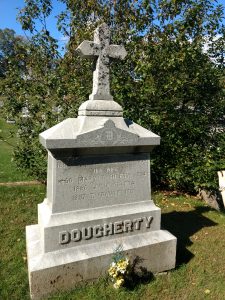I’ve spent the last couple days transcribing Irish names that we found on graves in the local cemetery and trying to decipher names and dates. Some things I just couldn’t make out, which was very frustrating. I used the HeritageQuest database to try to find these people, but I was mostly unsuccessful. I have used HeritageQuest before successfully so I know the database is a good one with detailed census and property records for this area, which made the fact that I couldn’t find most of these people really weird. It’s driving me nuts because some of the grave markers had things like “native of Dublin” on them, so we know that they we immigrants. I just can’t find record of them outside the cemetery.

The one name I found records of was one Michael Dougherty, who lived from 1860 to 1934. He was born in Ireland and emigrated in 1875, married Mary T. Sherry in 1890. He was literate. He worked in one of the local textile mills. He owned a house valued at $6,000 and had a radio!
